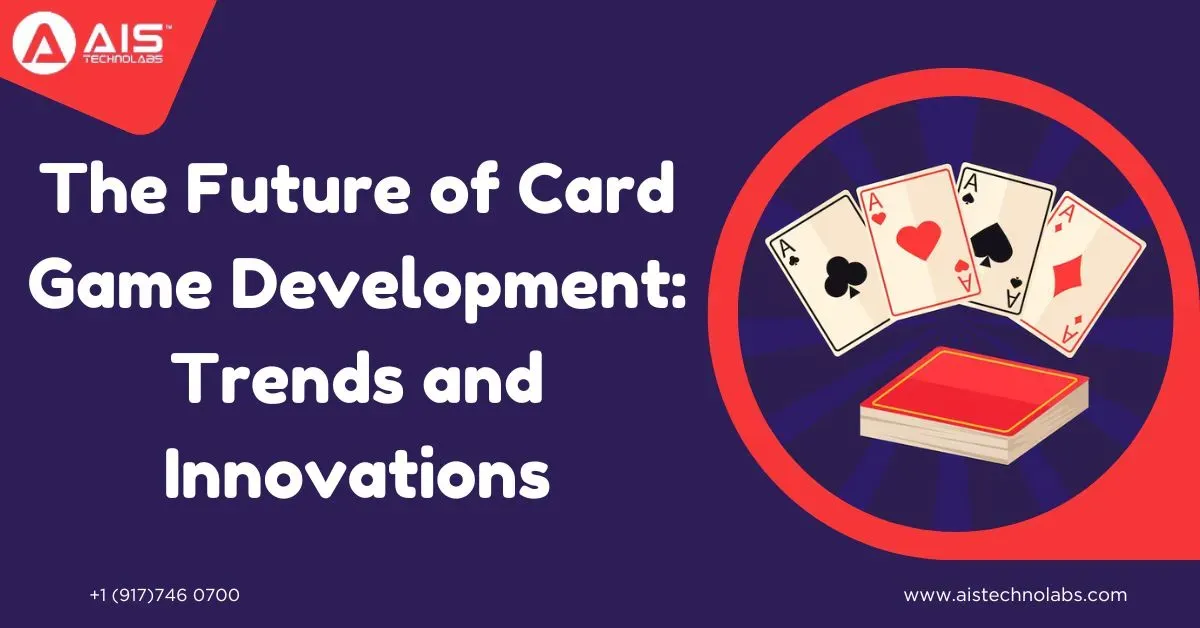Table of Content
(563 views)

Introduction
From the classic card games of Poker and Bridge to innovative, modern ways using digital means, card games have always brought fun. In this ever-changing environment of technology, the outlook toward card game development is now moving fast. But what does the future hold? Looking ahead towards 2025, there are several trends and developments that are going to strongly alter card games in terms of design, gameplay, and appeal. From immersive graphics and AI-driven gameplay to a surge in mobile gaming, the possibilities are endless!
If you’ve ever imagined playing your favorite card game with an entirely new set of features or even a game-changing twist, now is the time to start thinking big. Technology has indeed changed how game development is being approached, and the future of card game development is no different. Come 2025, and the creators of games really push the limits. Further ahead is a brief into the future for card game development and what could be expected in forthcoming years.
The Role of AI in Card Game Development
While AI is already contributing much to the development of card games, in 2025 it will be contributing more. Already, AI is helping the game developer build up a good opponent, providing personal experience with the taste of the games, and changing difficulties. Soon, AI will definitely revolutionize playing card games.
AI will introduce new improvements into game mechanics due to the change in behavior because of an intelligent opponent informed through moves that the player himself has previously made. Imagine a situation whereby all the matches would have been different, with AI
adjusting to how one had played beforehand and thus changing their game. More depth in such personalization, in single-player mode, will prove far more appealing and rewarding than what was previously fathomed.
Besides, AI will be applied in the design and testing of games. Machine learning algorithms will make it easier for designers, with the help of AI, to find problems, bugs, and ways of optimizing at each step of the process more quickly. By 2025, AI-powered video game development tools will have reduced the time to develop a new card game considerably, thus enabling developers to raise the bar for creativity without any compromise on quality.
Immersive Graphics and Augmented Reality
Soon enough, over these forthcoming few years, the card games would take that extra stride away from being just static cards in a screen toward another era of creation: that with augmented center-stage graphics, immersive to the core. The idea was for the game experiences to become way more akin to live and interactive ones, as opposed to those static versions of them.
Think poker or Magic: The Gathering, cards leaping off one's imagination to hover, almost real, over the table. Wholly new interactions could be invented, impossible until today, such as morphing cards right before your face, jumping dynamic characters or objects right off them, or playing in virtual 3D space.
This will, to some degree, blur the boundaries between real life and virtual life. Wearing augmented reality headsets around 2025, if one did not know how that was what was in store for them, and another realizably possible way through engaging yourself at playing your cards. Card gaming is not going to be on computers, smartphones versus the flat displays, since it could easily take those little things further: to ever so personal.
Mobile Gaming and Cross-Platform Play
Some of the trends that have prevailed and are going to keep on setting the pace for card game development during the next couple of years are mobile gaming and cross-platform play. With the huge popularity of smartphones, the efforts of developers today are directed at the creation of card games playable on every device, starting with mobile phones and finishing with VR headsets.
Key features of the card games in 2025 for them to be successful would be cross-platform games. This would also mean that players would not stick to just one platform in order to play. Be it on a phone, tablet, or computer, they can participate with their friends and opponents, whatever device they use.
This new trend has brought a complete new challenge to the developers of gameplay optimization on such a tremendous amount of devices while keeping it high wherever it is.
Playing a great quality card game in mobile phones, though, is going to get smoother and smoother with the cloud, making gaming much easier than it used to be, accompanied by faster Internets.
Blockchain and Digital Collectibles
Over the next few years, blockchain technology will surely knock down the barrier to a full new level for developing card games in terms of digital collectibles. The trade and collection possibility of virtual cards has already been proven in digital card games such as Hearthstone and Legends of Runeterra. However, blockchain technology makes this even better by giving ownership to the player through NFTs.
More precisely, one can say cards in the Digital Card Game possess value for reasons such as accumulating rare ones and selling those off or even trading them to just about anybody within the marketplace through physical cash. As such, blockchain would also make the content impossible to even be faked, much less copied, by bringing into effect exclusive scarcity towards a digital card marketplace.
Also, the use of blockchain in the development of card games will introduce more transparency into the in-game economy, where everything from ownership to trades and transactions can be tracked with ease by the owners. The ramifications in the market for collectible card games will be huge—one could imagine card games offering not just an immersive experience but an actual, real-world economic ecosystem around it!
Customized Gaming Experience
Aside from this, another future-shaping innovation in the development of card games is personalization. Indeed, with each year passing, players want to have more customized experiences, and this definitely is one of the focuses that game developers will be working on in the following years.
By 2025, card games will offer players a highly tailored experience that adapts to their individual preferences. Using data analytics and player feedback, game developers will design card games that adjust to each player’s unique playstyle, challenges, and progress. For example, if you’re a player who enjoys a slow-paced strategy game, the AI will adjust to your speed, making the game enjoyable and not too overwhelming.
None of this personalization will stop at the level of AI but will extend well into the game content: dynamic storyline, customizable avatar, and a game mode tailor-made for each player's liking—just what one can be sure of finding. Such is the trend in making card gaming more accessible to all, from casual to advanced.
Social and Competitive Card Gaming on the Rise
Last but not least, future development in card games will be increasing social gaming and competitive playing. Online multiplayer capability is sure to be pushed further ahead, where means of communication among the players would increase. For the year 2025, one may predict that there will be more in-game social functions, including in-game chats, live broadcasts, and real-time tournaments.
Actually, competitive eSports centered on card gaming is bound to continue being even more mainstream, as big money tournaments lure in only the best and most renowned around the world. Much as in the current scene today, where the likes of Fortnite and League of Legends reign at the top echelons, card games will also have leagues and international events.
The longer this goes, the more entertaining the card games get, and revenues begin to open up towards the developers. Prize pools, sponsorships, and live broadcasting are also showing up in parts of the card games within the ecosystem.
Conclusion:
But in the near future, playing card games will be ever more hi-tech and new-school, chock full of incredible functionalities, including integrations with artificial intelligence and AR, blockchain technologies, and finally competitive gaming, among other new inventions. Expect a strong guard change in what's in store for this next year, catering to players of immersion or a developer single-mindedly striving to push the limits on what could be possible in game design; 2025 will change the deal.
We couldn't agree more, and at AIS Technolabs, we actually believe in the next-in-trend future of card game development and how those will materialize. Come connect with experts who have experience in designing and developing the most sought-after next big thing in card gaming. Contact us today and start your journey ahead to develop the next revolutionary card game!
FAQs
AI will make a game more interactive, introducing adaptive opponents that may change and adapt to the player's strategy; thus, single-player modes become competitive too. AI facilitates the design and testing process.
Blockchain lets players actually own their in-game cards as NFTs, which is something that can have real-world value and even further create secure, transparent economies for card trading in-game.
This would let users interact more with the cards, making card gaming a lot more immersive, using animations and 3D environments for an overall real feel of gaming.
Well, sure enough, there continues to be more and more competitive card gaming tournaments featuring high prize pools, professional players, and the ability to stream events live—just like the traditional eSports landscape.

Mary Smith
Mary Smith excels in crafting technical and non-technical content, demonstrating precision and clarity. With careful attention to detail and a love for clear communication, she skillfully handles difficult topics, making them into interesting stories. Mary's versatility and expertise shine through her ability to produce compelling content across various domains, ensuring impactful storytelling that resonates with diverse audiences.